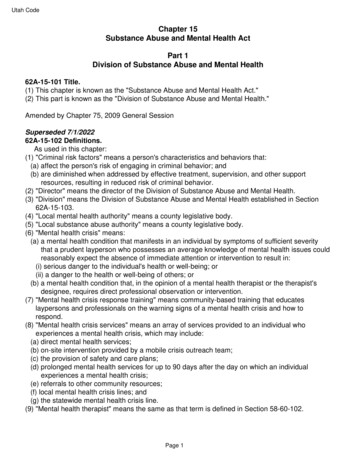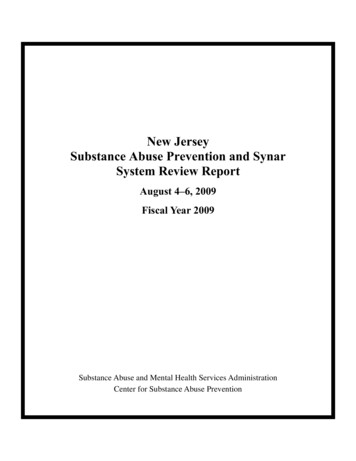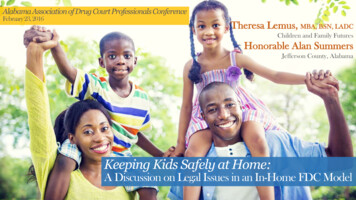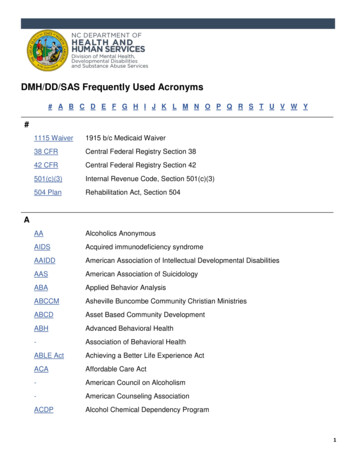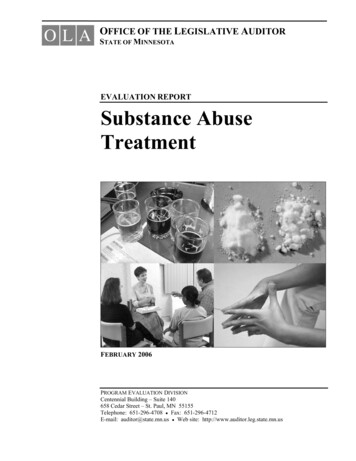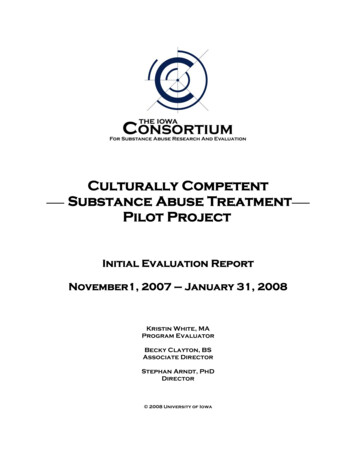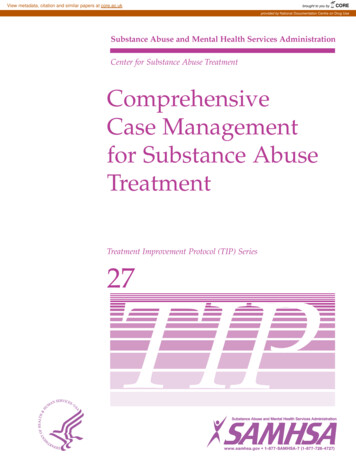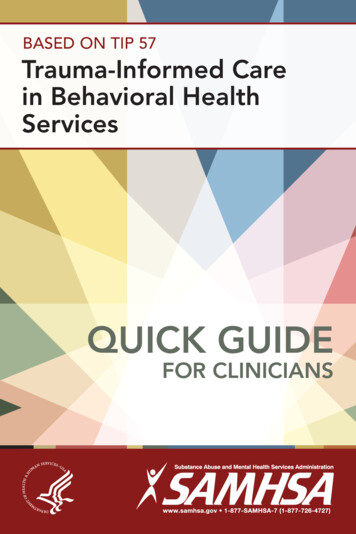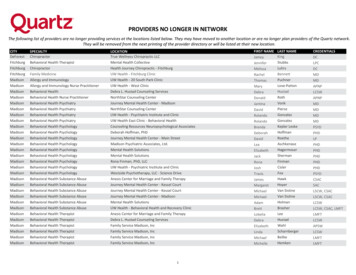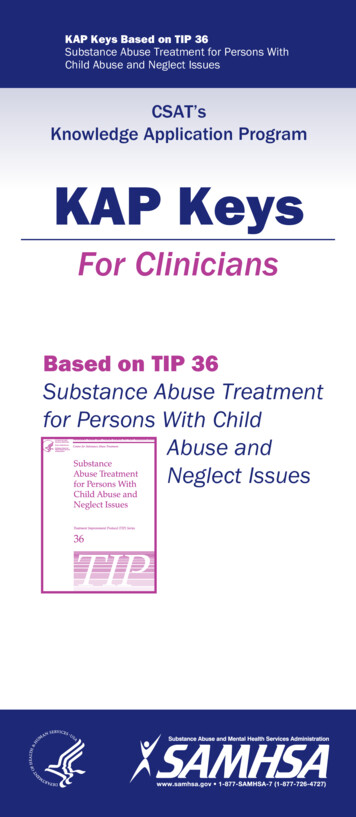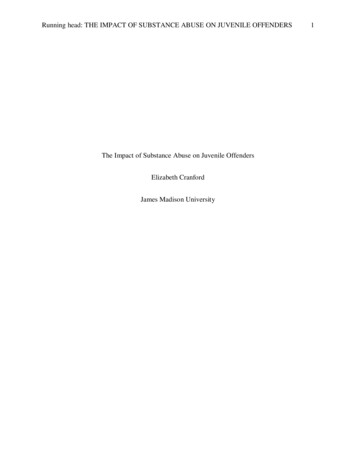
Transcription
Running head: THE IMPACT OF SUBSTANCE ABUSE ON JUVENILE OFFENDERSThe Impact of Substance Abuse on Juvenile OffendersElizabeth CranfordJames Madison University1
THE IMPACT OF SUBSTANCE ABUSE ON JUVENILE OFFENDERS2The Impact of Substance Abuse on Juvenile OffendersThis paper will focus on juvenile offenders in the United States and how use ofsubstances impacts this population. Specifically we will explore the effects of substance use,abuse and addiction within this population, what prevents juvenile offenders from gettingtreatment, and what treatment approaches have been discovered to be most effective with thisgroup.Juvenile Offenders and Substance AbuseIn the United States there is a separate court system to meet the needs of juvenileoffenders. In the 2004 analysis: Criminal Neglect: Substance Abuse, Juvenile Justice and TheChildren Left Behind it was stated that there are “2.4 million arrests of minors who end up in thejuvenile justice population (p. ii).” In 2003, approximately 96,000 juvenile offenders wereimprisoned (Himelstein, 2011, p. 1). Between 1994 and 2003 most juvenile offences declined(Young, Dembo, & Henderson, 2007, p. 255) and in recent years the rates of substance use byyouth has also decreased (Henderson, C., Young, D., Jainchill, N., Hawke, J., Farkas, S., &Davis, R., 2007, p.279) ; however, “the rate of [juvenile] arrests for drug abuse violationsincreased 19% with the increase being far greater among females (56%) than males (13%)”(Young, Dembo, & Henderson, 2007, p. 255).Research continues to show that there is a strong relationship between substance use andjuvenile delinquency, especially with more serious crimes. “Delinquents are more likely to usedrugs, and drug users are more likely to commit criminal offenses. Thus, criminal activity anddrug use are both risk factors for and consequences of each other” (Swenson, C. C., Henggeler,S. W., Taylor, I. S., & Addison, O. W., 2005, p. 13). In fact, “four of every five children and
THE IMPACT OF SUBSTANCE ABUSE ON JUVENILE OFFENDERS3teens (78.4 percent) in juvenile justice systems--1.9 of 2.4 million arrests of 10- to 17-year olds-are under the influence of alcohol or drugs while committing their crime, test positive for drugs,are arrested for committing an alcohol or drug offense, admit having substance abuse andaddiction problems, or share some combination of these characteristics” (The National Center onAddiction and Substance Abuse at Columbia University, 2004, p. 1). Other research showed“among adolescents detained for criminal offending in 2000, 56 percent of boys and 40 percentof girls tested positive for drug use” (Chassin, 2008, p.166). With that said, it has been found thatthere is not a difference in genders in the frequency of substance use disorders, specificallypertaining to alcohol or marijuana (Chassin, 2008, p. 167).It is important to note that drug use does not necessarily mean drug addiction. This isespecially significant since use of substances is highly prevalent among youth, particularly thosewho are older adolescents; however, only 3 percent of the general population is estimated ashaving a “diagnosable substance abuse or dependence disorder” (Swenson, et. al., 2005, p. 15).There is, however, a large difference between non-juvenile offenders and juvenile offenders insubstance use disorders. One study that focused on detainees in the Chicago, Illinois area foundthat about half of the juveniles met the criteria for a substance use disorder and 21% were foundto have two or more substance use disorders (Young, et. al., 2007, p. 255). Other researchersbelieve the percentage is smaller and estimate that only 10% of youth in the juvenile justicesystem meet the criteria for a diagnosis (Swenson et. al., 2005, p. 15). Regardless of theconflicting statistics, addiction is much more prevalent in juvenile offenders then the generaladolescent population.Another aspect to consider when focusing on this population is race. The Office ofJuvenile Justice and Delinquency Prevention found that black juveniles were arrested more every
THE IMPACT OF SUBSTANCE ABUSE ON JUVENILE OFFENDERS4year between 1981 and 2010 when looking at juvenile arrest rate trends for drug abuseviolations. 1980 was the only year that white juveniles were arrested more on drug abuseviolations. Other than the 1980 exception, white, American Indian, and Asian juvenile arrestsalways fell under blacks (in that order). Of course, these statistics have changed over the courseof the twenty year period. “Despite the substantial decline between 1995 and 2002 for blackjuveniles, the black [juvenile drug abuse violation] rate was nearly 50% above the white rate in2010” (Office of Juvenile Justice and Delinquency Prevention, 2012). “One study found thatsubstance use disorder rates among incarcerated, detained, or secured youth [for any crime] varyby race and ethnicity, with non-Hispanic Caucasians showing the highest rates and AfricanAmericans the lowest” (Chassin, 2008, p. 167). These statistics show that although blackjuveniles are arrested more for drug crimes, white juvenile offenders are more likely to have asubstance use disorder. This is true for both Non-Hispanic whites males and females (Teplin, L.A., Abram, K. M., McClelland, G. M., Mericle, A. A., Dulcan, M. K., & Washburn, J. J., 2006,p. 6).Art Mayer, from the Virginia Department of Behavior Health and DevelopmentalServices, presented information on what substances juvenile offenders are using in the state. Theresearch showed cigarettes (63.5%) are the most commonly used substance by youth in thejuvenile justice system in this state. This is closely followed by marijuana (63%) and alcohol(51.8%). Although the numbers are much smaller for other drugs it is important to note that thereare other substances being used – cocaine (8.8%), inhalants (3.4%), crack (2.6%), heroine (1.4%)(Mayer, A., 2001, slide 3).
THE IMPACT OF SUBSTANCE ABUSE ON JUVENILE OFFENDERS5Consequences of Substance Abuse and Juvenile OffendersResearch has repeatedly shown us that substance abuse and juvenile crimes areinterrelated (Carter, 2012; Chassin, 2008, p. 166; National Conference of State Legislatures, n.d.,p. 4; Swenson et. al., 2005, p. 13). Adolescent delinquents who abuse substances are more likelyto have a greater and longer involvement in the juvenile justice system (Carter, 2012; Henderson,et. al., 2007, p. 280). In fact, juveniles’ “severe substance abuse is associated with increased ratesof offending and more serious offenses” (Carter, 2012). As the levels of substance use increase,“the rate of offending, the severity of the committed offense, and the duration of antisocialbehavior” increases, as well (Young, et. al., 2007, p. 256).When focusing on juvenile offenders there is an obvious implication of these minorsfacing legal consequences, but other effects of their substance use and abuse should not beoverlooked. Untreated substance abuse can lead to an abundance of life-long obstacles, likefailing school (Henderson, et. al., 2007, p. 280), increased antisocial behavior (Carter, 2012), andhealth risks (Chassin,, 2008, p. 166). Sexual risky behavior is one of the health concernsassociated with substance use among this population. Higher exposure to sexually transmittedinfections, including HIV is a reality for juvenile offenders who use substances (Chassin, 2008,p.166; Young et. al., 2007, p.256). For substance using offenders who are also pregnant, the fetusis put in jeopardy and harm to fetal development could occur. Violence and an increase inaccidents are also consequence for juvenile offenders who use substances. Poor occupationaloutcomes are also a concern for this population (Chassin, 2008, p. 166).
THE IMPACT OF SUBSTANCE ABUSE ON JUVENILE OFFENDERS6Substance Abuse Treatment Obstacles for Juvenile OffendersTreatment for juvenile offenders’ substance use disorders is a difficult task because of thewide range of issues these young people face on daily basis. These hurdles include: schoolfailure and learning disabilities, parental substance use disorders, and family dysfunction(Chassin, 2008, p. 167). Legal difficulties can also create hurdles to appropriate treatment(Henderson, et. al., 2007, p. 279).One of the largest obstacles for juvenile offenders needing treatment for substance abuseis co-morbid mental health concerns. The reality is that substance use disorders are the mostcommon co-occurrence with a mental illness and “these disorders put children at risk fortroublesome behavior and delinquent acts” (National Conference of State Legislatures, n.d., p.3). Teplin et. al. found that over 20% of males and almost 30% of females with a substance usedisorder “also had a major mental disorder. Among youth with drug and alcohol use disorders,more than one-third of females and more than one-quarter of males had a major mental disorder”(2006, p.7). The researchers looked for differences between gender, ethnicity, and age but didnot find anything significant (Teplin et. al., 2006, p.7). Some research has shown that girls aremore likely to have a co-occurring disorder, with a substance use disorder, than males. Forexample, anxiety and depression are quite common for female detainees (Chassin, 2008, p. 167).Also some juvenile offenders have multiple psychiatric disorders that need to be addressed(Henderson, et. al., 2007, p. 279). Unfortunately co-existing mental health concerns can be anobstacle for treatment for substance use disorders since it complicates treatment (Teplin et. al.2006, p. 7).
THE IMPACT OF SUBSTANCE ABUSE ON JUVENILE OFFENDERS7Another problem is that although many juvenile offenders have mental health needs,including substance use disorders, they are not all being screened once detained. In many statesthere is not a protocol for how to assess juveniles’ mental health; however, some states are nowrealizing the importance of early detection. “According to the National Center for Mental Healthand Juvenile Justice, youths who immediately receive a mental health screening are more likelyto have their problems identified and treated” (National Conference of State Legislatures, n.d., p.4). Nevada is a great example of a state taking action. All juveniles who are held for detentionhearings will now be screened for mental health and substance abuse problems in this state. Theresults of each screening and suggested treatment plan will be shared with the juvenile courts.Other states are requiring evaluations based on the crime. For example, Oregon requires anyadolescent who commits an alcohol-related crime to be assessed and given a treatment plan,including drug and alcohol education (National Conference of State Legislatures, n.d., p. 4).The treatment itself can also create an obstacle for juvenile offenders’ recovery fromsubstance use disorders. There are many treatments available, but it should be mentioned that“no single treatment approach has been proven most effective” (Chassin, 2008, p. 165). It hasbeen established that “treatments available for these youth often do not provide thecomprehensive, multifaceted services that these youth need” (Henderson, et. al., 2007, p. 279).Many times there are not enough treatment spots available to meet the needs of the juvenileoffenders who have substance use disorders. Laurie Chassin suggested a “substantial unmettreatment need among juvenile offenders” (2008, p. 170). Laura Burney Nissen and JessicaPearce agreed that many of the adolescents in the juvenile justice system need a “qualitysubstance abuse intervention but are unlikely to get one” (2011, p. S60).
THE IMPACT OF SUBSTANCE ABUSE ON JUVENILE OFFENDERS8The juveniles themselves can also cause a barrier to treatment. Many juveniles, includingadolescent offenders, do not see a need for treatment. Their lack of interest and dedication makeit difficult to engage this age group, as well as keep them in treatment. In addition to the effectsof the teenagers’ attitude, getting juvenile offenders to participate in aftercare services can alsoprove difficult (Chassin, 2008, p. 173).In addition to the limited space, researchers have found that this population is especiallydifficult to treat for substance use disorders. Tripodi and Bender found individual basedtreatments and family based treatments are far less successful with juvenile offenders than theirpeers in the general population (2011, p. 250). Because of this difficulty it is especially importantfor new studies to be created and researched to ensure that the most effective treatments areavailable.Effective Treatment ApproachesAs mentioned earlier, there are many different types of treatments available for juvenileoffenders with substance use disorders; however, not all have been proven effective. Thankfullyas more research is complete there is data to suggest that there are effective treatment approachesto either enhance previously used tactics or completely new methods that assist juvenileoffenders with their substance use disorders. This paper will take a closer look at four treatmentapproaches, which include: multi-systemic therapy (MST), family functioning therapy, juveniledrug courts, and mindfulness. There are other treatments that are not covered in this paper thathave also shown positive outcomes and are effective when working with juvenile offenders whouse or abuse substances.
THE IMPACT OF SUBSTANCE ABUSE ON JUVENILE OFFENDERS9Multi-systemic Therapy (MST)Multi-systemic therapy (MST) is a multi-systems approach created from the socioecological model of development. MST is especially noteworthy since it is the only program thatis listed as “effective” on the crimesolutions.gov website when the results have been filtered toonly include “juvenile offenders” under topic and “alcohol and drug therapy/treatment” underprogram type (National Institute of Justice, n.d.). “The premise of the approach is that substanceuse is a function of the effects of multiple systems and youths’ interactions with each system”(Tripodi & Bender, 2011, p. 250). This method used to assist juvenile offenders who have asubstance use disorder is very intensive, as well as interactive. Clinicians, who can be reached 24hours a day in case of a crisis, are assigned to a minor and his/her family. Families also receive50 hours of counseling over a four-month period (The Future of Children, n.d., p.4). Cliniciansprovide in-home services which are goal oriented: focusing on finding resources and assetswithin each system, as well as improving or limiting risk factors if possible. One way that this isaccomplished is by working with the adolescent to identify pro-social peers, rather than thosewho participate in delinquent behaviors. This approach is ultimately trying to change the “familysystem with the youth present” (Tripodi & Bender, 2011, p.251). Collaboration with othercommunity resources is also a key part of MST, which also allows MST teams to decreaseobstacles to other services. The downside with this approach is the cost; however, cost-benefitanalysis have found that this approach is preferred over “punitive sentences to locked facilities”(Tripodi & Bender, 2011, p. 250). With that said, MST proves to have positive results. One studyfound that MST “significantly reduced substance use among juvenile offenders,” while otherstudies found mixed results such as a decline in marijuana use but not in other measuredsubstances (Chassin, 2008, p. 172).
THE IMPACT OF SUBSTANCE ABUSE ON JUVENILE OFFENDERS10Functional Family Therapy (FFT)This approach’s goal is to improve family dynamics and focuses on teenagers 11 to 18years of age who struggle with delinquency, violence, or substance abuse. “Specifically,individual therapists work with a family in the home to improve problem solving, increaseemotional connections, and strengthen parents’ abilities to provide structure, guidance, and limitsfor their children” (The Future of Children, n.d., p. 4). Unlike MST, this program is seen as“highly cost effective,” as well as a successful intervention program (Carter, 2012). The primarydifference is that FFT is not as intensive, nor does it provide as comprehensive of services asMST (Carter, 2012).Juvenile Drug CourtsThere are over 400 juvenile drug courts operating in the United States (Nissen & Pearce,2011, p. S61), but research has shown “mixed evidence of their effectiveness in treatingsubstance-abusing juvenile offenders” (Henggeler, S. W., McCart, M. R., Cunningham, P. B., &Chapman, J. E., 2012, p.264). These drug courts screen juvenile offenders to see if they meet the“eligibility criteria,” which is defined by a planning team, who considers funding limitations andavailability of treatment resources. These courts use sixteen strategies to meet the needs of theyouth they serve: clearly defined target population and eligibility criteria, collaborative planning,community partnerships, comprehensive treatment planning, confidentiality, culture competence,developmentally appropriate services, drug testing, educational linkages, family engagement,focus on strengths, gender-appropriate services, goal-oriented incentives and sanctions, judicialinvolvement and supervision, monitoring and evaluation, and teamwork (National Council ofJuvenile and Family Court Judges, n.d.). Juvenile drug courts prove to be effective but they only
THE IMPACT OF SUBSTANCE ABUSE ON JUVENILE OFFENDERS11focus on a narrow population. From this treatment approach we have learned how impactfulsystem collaboration and community engagement is and can be for juvenile offenders withsubstance use disorders. Further research has shown that juvenile drug court can have an evengreater effect with combined with other treatment approaches, such as contingency managementand family engagement strategies (Henggeler, et. al., 2012).MindfulnessMindfulness has recently gained popularity in counseling and psychology fields alike andthis approach has found its way into substance abuse treatment programs, as well. One group thatfocuses a lot about incarcerated youth is the Mind Body Awareness Project. They developed aprogram that is a “10-module mindfulness intervention tailored specifically to the needs ofextremely high-risk and incarcerated adolescents” (Himelstein, 2011, p. 3). This approach istailored to meet the needs of this population by focusing activities and conversations aroundissues that juvenile offenders face, including substance use and abuse. Mindfulness meditation,didactic training, group process, and informal mindfulness exercises are all included in thisapproach (Himelstein, 2011, p. 3).After Sam Himelstein reviewed the literature on the positive effects mindfulnesspractices can have with adolescents and incarcerated youth he decided to create a mindfulnessprogram that had specific interventions for substance using incarcerated youth for a researchstudy. As a result, he created “this mindfulness-based substance use intervention [which] is agroup-based therapeutic treatment that incorporates formal and informal mindfulness practices,didactic drug education, experiential exercise, and group discussion into each module”(Himelstien, 2011, p. 4). Past research was supported by his results and although more research
THE IMPACT OF SUBSTANCE ABUSE ON JUVENILE OFFENDERS12needs to be conducted with this approach, mindfulness-based interventions do seem to be aviable option for substance using juvenile offenders or individuals at high-risk (Himelstien,2011).ConclusionResearch shows us that substance use or abuse is quite common for juvenile offenders.Studies have also shown that “between 65 percent and 70 percent of the 2 million children andadolescents arrested each year in the United States have a mental health disorder,” includingsubstance use disorders (National Conference of State Legislatures, n.d., p.2). Substance abuseand juvenile crime is currently very cyclical, but it does not have to be. Although juvenileoffenders with substance use disorders can be difficult to treat there are effective treatmentapproaches, as well as new ones that seem promising, to assist these minors in recovery, but alsoin their lives overall. Treatments like Multi-systemic therapy (MST) and Family FunctioningTherapy (FFT) have proven to be effective over time, while Mindfulness looks like a promisingapproach. The Juvenile Drug Court system has been present for many years and now researchersare finding ways to make it even more effective. Clearly more research needs to be focused onsubstance abuse and juvenile offenders. Studies that build on one another to show consistenteffectiveness of an approach would be one approach to further research. Overall juvenileoffenders and substance use go hand in hand. Continued research will help these adolescentsbuild a successful life for themselves outside of the juvenile justice system.
THE IMPACT OF SUBSTANCE ABUSE ON JUVENILE OFFENDERS13ReferencesCarter, S. (2012, October 15). The relationship between substance abuse and teen crime. ReclaimingFutures: Communities Helping Teens Overcome Drugs, Alcohol & Crime. Retrieved November17, 2013, from use-among-teen-offendersChassin, L. (2008). Juvenile justice and substance use. Futureofchildren.org, 18(2), 165-183. RetrievedNovember 16, 2013, ublications/docs/18 02 08.pdfEstroff, T. W. (2001). Manual of adolescent substance abuse treatment. Washington, D.C.: AmericanPsychiatric Press.The Future of Children. (n.d.). Best Practices in Juvenile Justice Reform. The Future of Children.Retrieved November 17, 2013, ications/highlights/18 02 Highlights.pdfHenderson, C., Young, D., Jainchill, N., Hawke, J., Farkas, S., & Davis, R. (2007). Program use ofeffective drug abuse treatment practices for juvenile offenders. Journal of Substance AbuseTreatment, 32(3), 279-290. doi: 10.1016/j.jsat.2006.12.021Henggeler, S. W., McCart, M. R., Cunningham, P. B., & Chapman, J. E. (2012). Enhancing theeffectiveness of juvenile drug courts by integrating evidence-based practices. Journal ofConsulting and Clinical Psychology,80(2), 264-275. doi: 10.1037/a0027147Himelstein, S. (2011). Mindfulness-based substance abuse treatment for incarcerated youth: A mixedmethod pilot study. International Journal of Transpersonal Studies, 30, 1-10.Mayer, A. (2011, June 21). Department of juvenile justice substance abuse treatment programs: Anoverview for the substance abuse service counsel [PowerPoint slides]. Retrieved from Virginia
THE IMPACT OF SUBSTANCE ABUSE ON JUVENILE OFFENDERS14Department of Behavioral Health and Developmental Serviceswebsite: DJJ-Presentation2011-06.pdfThe National Center on Addiction and Substance Abuse at Columbia University. (2004,October). Criminal Neglect: Substance Abuse, Juvenile Justice and the Children Left behind.Retrieved November 16, 2013, from al%20Neglect.pdfNational Conference of State Legislatures. (n.d.). Mental health needs of juvenile offenders. RetrievedNovember 17, 2013, from l.pdfNational Council of Juvenile and Family Court Judges. (n.d.). Juvenile drug courts. Juvenile DrugCourts. Retrieved November 17, 2013, from National Institute of Justice. (n.d.). Juveniles. CrimeSolutions.gov. Retrieved November 16, 2013, x?ID 5Nissen, L. B., & Pearce, J. (2011). Exploring the implementation of justice-based alcohol and drugintervention strategies with juvenile offenders: Reclaiming Futures, enhanced adolescentsubstance abuse treatment, and juvenile drug courts. Children and Youth Services Review, 33,S60-S65. doi: 10.1016/j.childyouth.2011.06.014Nissen, L. B., & Pearce, J. (2011). Exploring the implementation of justice-based alcohol and drugintervention strategies with juvenile offenders: Reclaiming Futures, enhanced adolescentsubstance abuse treatment, and juvenile drug courts. Children and Youth Services Review, 33,S60-S65. doi: 10.1016/j.childyouth.2011.06.014
THE IMPACT OF SUBSTANCE ABUSE ON JUVENILE OFFENDERS15Office of Juvenile Justice and Delinquency Prevention. (2012, December 17). Juvenile Arrest RateTrends. Juvenile Arrest Rate Trends. Retrieved November 17, 2013, fromhttp://www.ojjdp.gov/ojstatbb/crime/JAR Display.asp?ID qa05274Program profile: Multisystemic therapy - substance abuse. (n.d.). Program: Multisystemic Therapy–Substance Abuse. Retrieved November 17, 2013, spx?ID 179Swenson, C. C., Henggeler, S. W., Taylor, I. S., & Addison, O. W. (2005). Multisystemic therapy andneighborhood partnerships: Reducing adolescent violence and substance abuse. New York, NY:Guilford Press.Teplin, L. A., Abram, K. M., McClelland, G. M., Mericle, A. A., Dulcan, M. K., & Washburn, J. J.(2006, April). Psychiatric disorders of youth in detention. Juvenile Justice Bulletin. RetrievedNovember 17, 2013, from ipodi, S. J., & Bender, K. (2011). Substance abuse treatment for juvenile offenders: A review ofquasi-experimental and experimental research. Journal of Criminal Justice, 39, 246-252. doi:10.1016/j.jcrimjus.2011.02.007Young, D., Dembo, R., & Henderson, C. (2007). A national survey of substance abuse treatment forjuvenile offenders. Journal of Substance Abuse Treatment, 32(3), 255-266. doi:10.1016/j.jsat.2006.12.018
is put in jeopardy and harm to fetal development could occur. Violence and an increase in . The treatment itself can also create an obstacle for juvenile offenders' recovery from substance use disorders. There are many treatments available, but it should be mentioned that . substance abuse intervention but are unlikely to get one" (2011 .


